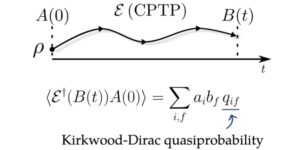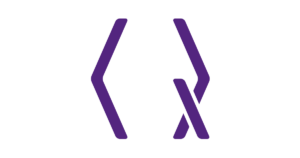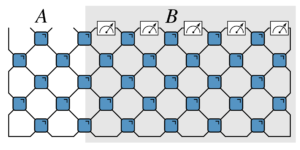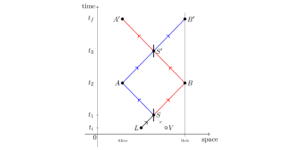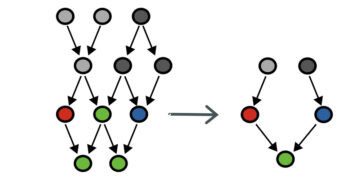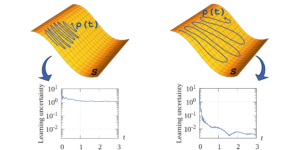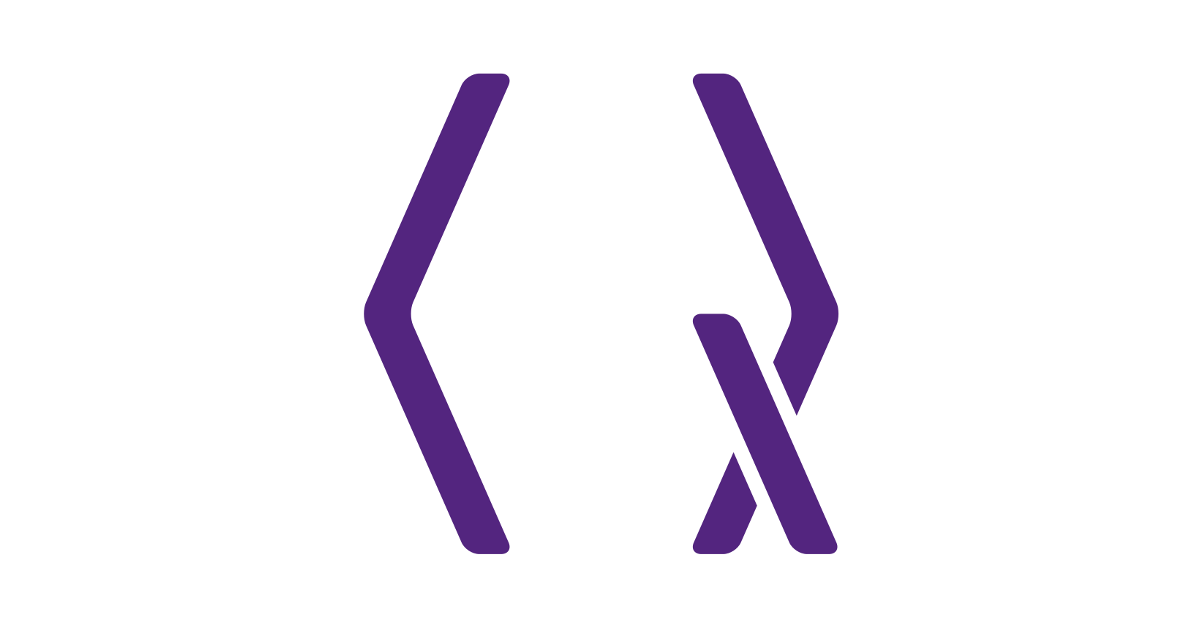
Leiden University, Leiden, The Netherlands
Find this paper interesting or want to discuss? Scite or leave a comment on SciRate.
Abstract
Quantum computers hold great promise to enhance machine learning, but their current qubit counts restrict the realisation of this promise. To deal with this limitation the community has produced a set of techniques for evaluating large quantum circuits on smaller quantum devices. These techniques work by evaluating many smaller circuits on the smaller machine, that are then combined in a polynomial to replicate the output of the larger machine. This scheme requires more circuit evaluations than are practical for general circuits. However, we investigate the possibility that for certain applications many of these subcircuits are superfluous, and that a much smaller sum is sufficient to estimate the full circuit. We construct a machine learning model that may be capable of approximating the outputs of the larger circuit with much fewer circuit evaluations. We successfully apply our model to the task of digit recognition, using simulated quantum computers much smaller than the data dimension. The model is also applied to the task of approximating a random 10 qubit PQC with simulated access to a 5 qubit computer, even with only relatively modest number of circuits our model provides an accurate approximation of the 10 qubit PQCs output, superior to a neural network attempt. The developed method might be useful for implementing quantum models on larger data throughout the NISQ era.
► BibTeX data
► References
[1] J Avron, Ofer Casper, and Ilan Rozen. Quantum advantage and noise reduction in distributed quantum computing. Physical Review A, 104 (5): 052404, 2021. 10.1103/PhysRevA.104.052404.
https://doi.org/10.1103/PhysRevA.104.052404
[2] S Balakrishnan and R Sankaranarayanan. Operator-schmidt decomposition and the geometrical edges of two-qubit gates. Quantum Information Processing, 10 (4): 449–461, 2011. 10.1007/s11128-010-0207-9.
https://doi.org/10.1007/s11128-010-0207-9
[3] Peter L Bartlett and Shahar Mendelson. Rademacher and gaussian complexities: Risk bounds and structural results. Journal of Machine Learning Research, 3 (Nov): 463–482, 2002. 10.1007/3-540-44581-1_15.
https://doi.org/10.1007/3-540-44581-1_15
[4] Saikat Basu, Amit Saha, Amlan Chakrabarti, and Susmita Sur-Kolay. $ i $-qer: An intelligent approach towards quantum error reduction. arXiv preprint arXiv:2110.06347, 2021. 10.1145/3539613.
https://doi.org/10.1145/3539613
arXiv:2110.06347
[5] Marvin Bechtold. Bringing the concepts of virtualization to gate-based quantum computing. Master’s thesis, University of Stuttgart, 2021.
[6] Sergey Bravyi, Graeme Smith, and John A Smolin. Trading classical and quantum computational resources. Physical Review X, 6 (2): 021043, 2016. 10.1103/PhysRevX.6.021043.
https://doi.org/10.1103/PhysRevX.6.021043
[7] Matthias C Caro, Elies Gil-Fuster, Johannes Jakob Meyer, Jens Eisert, and Ryan Sweke. Encoding-dependent generalization bounds for parametrized quantum circuits. arXiv preprint arXiv:2106.03880, 2021. 10.22331/q-2021-11-17-582.
https://doi.org/10.22331/q-2021-11-17-582
arXiv:2106.03880
[8] Gavin E Crooks. Gradients of parameterized quantum gates using the parameter-shift rule and gate decomposition. arXiv preprint arXiv:1905.13311, 2019. 10.48550/arXiv.1905.13311.
https://doi.org/10.48550/arXiv.1905.13311
arXiv:1905.13311
[9] Li Deng. The mnist database of handwritten digit images for machine learning research. IEEE Signal Processing Magazine, 29 (6): 141–142, 2012. 10.1109/MSP.2012.2211477.
https://doi.org/10.1109/MSP.2012.2211477
[10] Edward Farhi and Hartmut Neven. Classification with quantum neural networks on near term processors. arXiv preprint arXiv:1802.06002, 2018. 10.48550/arXiv.1802.06002.
https://doi.org/10.48550/arXiv.1802.06002
arXiv:1802.06002
[11] Keisuke Fujii, Kaoru Mizuta, Hiroshi Ueda, Kosuke Mitarai, Wataru Mizukami, and Yuya O Nakagawa. Deep variational quantum eigensolver: a divide-and-conquer method for solving a larger problem with smaller size quantum computers. PRX Quantum, 3 (1): 010346, 2022. 10.1103/PRXQuantum.3.010346.
https://doi.org/10.1103/PRXQuantum.3.010346
[12] Francisco Javier Gil Vidal and Dirk Oliver Theis. Input redundancy for parameterized quantum circuits. Frontiers in Physics, 8: 297, 2020. 10.48550/arXiv.1901.11434.
https://doi.org/10.48550/arXiv.1901.11434
[13] Tobias Haug, Chris N Self, and M S Kim. Quantum machine learning of large datasets using randomized measurements. Machine Learning: Science and Technology, 4 (1): 015005, jan 2023. 10.1088/2632-2153/acb0b4.
https://doi.org/10.1088/2632-2153/acb0b4
[14] Vojtěch Havlíček, Antonio D Córcoles, Kristan Temme, Aram W Harrow, Abhinav Kandala, Jerry M Chow, and Jay M Gambetta. Supervised learning with quantum-enhanced feature spaces. Nature, 567 (7747): 209–212, 2019. 10.1038/s41586-019-0980-2.
https://doi.org/10.1038/s41586-019-0980-2
[15] Hsin-Yuan Huang, Michael Broughton, Masoud Mohseni, Ryan Babbush, Sergio Boixo, Hartmut Neven, and Jarrod R. McClean. Power of data in quantum machine learning. Nature Communications, 12 (1), May 2021. ISSN 2041-1723. 10.1038/s41467-021-22539-9. URL http://dx.doi.org/10.1038/s41467-021-22539-9.
https://doi.org/10.1038/s41467-021-22539-9
[16] Sofiene Jerbi, Casper Gyurik, Simon Marshall, Hans J Briegel, and Vedran Dunjko. Variational quantum policies for reinforcement learning. arXiv preprint arXiv:2103.05577, 2021. 10.48550/arXiv.2103.05577.
https://doi.org/10.48550/arXiv.2103.05577
arXiv:2103.05577
[17] js21 (https://mathoverflow.net/users/21724/js21). Product of estimates of mean values – concentration of measure inequality. MathOverflow. URL https://mathoverflow.net/q/286787. URL:https://mathoverflow.net/q/286787 (version: 2017-11-23).
https://mathoverflow.net/q/286787
[18] Abhinav Kandala, Antonio Mezzacapo, Kristan Temme, Maika Takita, Markus Brink, Jerry M Chow, and Jay M Gambetta. Hardware-efficient variational quantum eigensolver for small molecules and quantum magnets. Nature, 549 (7671): 242–246, 2017. 10.1038/nature23879.
https://doi.org/10.1038/nature23879
[19] Weikang Li, Sirui Lu, and Dong-Ling Deng. Quantum federated learning through blind quantum computing. Science China Physics, Mechanics & Astronomy, 64 (10): 1–8, 2021. 10.1007/s11433-021-1753-3.
https://doi.org/10.1007/s11433-021-1753-3
[20] Jin-Guo Liu and Lei Wang. Differentiable learning of quantum circuit born machines. Physical Review A, 98 (6): 062324, 2018. 10.1103/PhysRevA.98.062324.
https://doi.org/10.1103/PhysRevA.98.062324
[21] Jarrod R McClean, Sergio Boixo, Vadim N Smelyanskiy, Ryan Babbush, and Hartmut Neven. Barren plateaus in quantum neural network training landscapes. Nature communications, 9 (1): 1–6, 2018. 10.1038/s41467-018-07090-4.
https://doi.org/10.1038/s41467-018-07090-4
[22] Kosuke Mitarai and Keisuke Fujii. Constructing a virtual two-qubit gate by sampling single-qubit operations. New Journal of Physics, 23 (2): 023021, 2021a. 10.1088/1367-2630/abd7bc.
https://doi.org/10.1088/1367-2630/abd7bc
[23] Kosuke Mitarai and Keisuke Fujii. Overhead for simulating a non-local channel with local channels by quasiprobability sampling. Quantum, 5: 388, 2021b. 10.22331/q-2021-01-28-388.
https://doi.org/10.22331/q-2021-01-28-388
[24] Mehryar Mohri, Afshin Rostamizadeh, and Ameet Talwalkar. Foundations of machine learning. MIT press, 2018. 10.1007/s00362-019-01124-9.
https://doi.org/10.1007/s00362-019-01124-9
[25] Tianyi Peng, Aram W Harrow, Maris Ozols, and Xiaodi Wu. Simulating large quantum circuits on a small quantum computer. Physical Review Letters, 125 (15): 150504, 2020. 10.1103/PhysRevLett.125.150504.
https://doi.org/10.1103/PhysRevLett.125.150504
[26] Michael A Perlin, Zain H Saleem, Martin Suchara, and James C Osborn. Quantum circuit cutting with maximum-likelihood tomography. npj Quantum Information, 7 (1): 1–8, 2021. 10.1038/s41534-021-00390-6.
https://doi.org/10.1038/s41534-021-00390-6
[27] Evan Peters, João Caldeira, Alan Ho, Stefan Leichenauer, Masoud Mohseni, Hartmut Neven, Panagiotis Spentzouris, Doug Strain, and Gabriel N Perdue. Machine learning of high dimensional data on a noisy quantum processor. npj Quantum Information, 7 (1): 1–5, 2021. 10.48550/arXiv.2101.09581.
https://doi.org/10.48550/arXiv.2101.09581
[28] John Preskill. Quantum computing in the nisq era and beyond. Quantum, 2: 79, 2018. 10.22331/q-2018-08-06-79.
https://doi.org/10.22331/q-2018-08-06-79
[29] Stefan H Sack, Raimel A Medina, Alexios A Michailidis, Richard Kueng, and Maksym Serbyn. Avoiding barren plateaus using classical shadows. arXiv preprint arXiv:2201.08194, 2022. 10.1103/PRXQuantum.3.020365.
https://doi.org/10.1103/PRXQuantum.3.020365
arXiv:2201.08194
[30] Zain H Saleem, Teague Tomesh, Michael A Perlin, Pranav Gokhale, and Martin Suchara. Quantum divide and conquer for combinatorial optimization and distributed computing. arXiv preprint arXiv:2107.07532, 2021. 10.48550/arXiv.2107.07532.
https://doi.org/10.48550/arXiv.2107.07532
arXiv:2107.07532
[31] Maria Schuld and Nathan Killoran. Quantum machine learning in feature hilbert spaces. Physical review letters, 122 (4): 040504, 2019. 10.1103/PhysRevLett.122.040504.
https://doi.org/10.1103/PhysRevLett.122.040504
[32] Maria Schuld, Ryan Sweke, and Johannes Jakob Meyer. Effect of data encoding on the expressive power of variational quantum-machine-learning models. Physical Review A, 103 (3): 032430, 2021. 10.1103/PhysRevA.103.032430.
https://doi.org/10.1103/PhysRevA.103.032430
[33] Wei Tang, Teague Tomesh, Martin Suchara, Jeffrey Larson, and Margaret Martonosi. Cutqc: using small quantum computers for large quantum circuit evaluations. In Proceedings of the 26th ACM International Conference on Architectural Support for Programming Languages and Operating Systems, pages 473–486, 2021. 10.1145/3445814.3446758.
https://doi.org/10.1145/3445814.3446758
[34] Stephen J Wright. Coordinate descent algorithms. Mathematical Programming, 151 (1): 3–34, 2015. 10.48550/arXiv.1502.04759.
https://doi.org/10.48550/arXiv.1502.04759
[35] LeCun Yann. If you listen carefully, you can hear the goat screaming “MNIST results!” But the dude isn’t listening carefully. Twitter, 2022.
https://twitter.com/ylecun/status/1481327585640521728
[36] Xiao Yuan, Jinzhao Sun, Junyu Liu, Qi Zhao, and You Zhou. Quantum simulation with hybrid tensor networks. Physical Review Letters, 127 (4): 040501, 2021. 10.1103/PhysRevLett.127.040501.
https://doi.org/10.1103/PhysRevLett.127.040501
Cited by
[1] Arsenii Senokosov, Alexander Sedykh, Asel Sagingalieva, and Alexey Melnikov, “Quantum machine learning for image classification”, arXiv:2304.09224, (2023).
[2] Christian Ufrecht, Maniraman Periyasamy, Sebastian Rietsch, Daniel D. Scherer, Axel Plinge, and Christopher Mutschler, “Cutting multi-control quantum gates with ZX calculus”, arXiv:2302.00387, (2023).
[3] Angus Lowe, Matija Medvidović, Anthony Hayes, Lee J. O’Riordan, Thomas R. Bromley, Juan Miguel Arrazola, and Nathan Killoran, “Fast quantum circuit cutting with randomized measurements”, Quantum 7, 934 (2023).
[4] Lirandë Pira and Chris Ferrie, “An Invitation to Distributed Quantum Neural Networks”, arXiv:2211.07056, (2022).
[5] L. Wright, F. Barratt, J. Dborin, V. Wimalaweera, B. Coyle, and A. G. Green, “Deterministic Tensor Network Classifiers”, arXiv:2205.09768, (2022).
[6] Cenk Tüysüz, Giuseppe Clemente, Arianna Crippa, Tobias Hartung, Stefan Kühn, and Karl Jansen, “Classical Splitting of Parametrized Quantum Circuits”, arXiv:2206.09641, (2022).
[7] Patrick Huembeli, Giuseppe Carleo, and Antonio Mezzacapo, “Entanglement Forging with generative neural network models”, arXiv:2205.00933, (2022).
[8] Marvin Bechtold, Johanna Barzen, Frank Leymann, Alexander Mandl, Julian Obst, Felix Truger, and Benjamin Weder, “Investigating the effect of circuit cutting in QAOA for the MaxCut problem on NISQ devices”, arXiv:2302.01792, (2023).
[9] Adrián Pérez-Salinas, Radoica Draškić, Jordi Tura, and Vedran Dunjko, “Reduce&chop: Shallow circuits for deeper problems”, arXiv:2212.11862, (2022).
[10] Tuhin Khare, Ritajit Majumdar, Rajiv Sangle, Anupama Ray, Padmanabha Venkatagiri Seshadri, and Yogesh Simmhan, “Parallelizing Quantum-Classical Workloads: Profiling the Impact of Splitting Techniques”, arXiv:2305.06585, (2023).
[11] Ryo Nagai, Shu Kanno, Yuki Sato, and Naoki Yamamoto, “Quantum channel decomposition with pre- and post-selection”, arXiv:2305.11642, (2023).
[12] Charles Moussa, Jan N. van Rijn, Thomas Bäck, and Vedran Dunjko, “Hyperparameter Importance of Quantum Neural Networks Across Small Datasets”, arXiv:2206.09992, (2022).
[13] Michele Cattelan and Sheir Yarkoni, “Parallel circuit implementation of variational quantum algorithms”, arXiv:2304.03037, (2023).
The above citations are from SAO/NASA ADS (last updated successfully 2023-08-10 03:13:01). The list may be incomplete as not all publishers provide suitable and complete citation data.
On Crossref’s cited-by service no data on citing works was found (last attempt 2023-08-10 03:12:54).
This Paper is published in Quantum under the Creative Commons Attribution 4.0 International (CC BY 4.0) license. Copyright remains with the original copyright holders such as the authors or their institutions.
- SEO Powered Content & PR Distribution. Get Amplified Today.
- PlatoData.Network Vertical Generative Ai. Empower Yourself. Access Here.
- PlatoAiStream. Web3 Intelligence. Knowledge Amplified. Access Here.
- PlatoESG. Automotive / EVs, Carbon, CleanTech, Energy, Environment, Solar, Waste Management. Access Here.
- BlockOffsets. Modernizing Environmental Offset Ownership. Access Here.
- Source: https://quantum-journal.org/papers/q-2023-08-09-1078/
- :has
- :is
- :not
- 1
- 10
- 11
- 12
- 13
- 14
- 15%
- 16
- 17
- 19
- 20
- 2011
- 2012
- 2015
- 2016
- 2017
- 2018
- 2019
- 2020
- 2021
- 2022
- 2023
- 22
- 23
- 24
- 25
- 26%
- 26th
- 27
- 28
- 30
- 31
- 32
- 33
- 36
- 7
- 8
- 9
- 98
- a
- above
- ABSTRACT
- access
- accurate
- ACM
- across
- ADvantage
- affiliations
- Alan
- Alexander
- algorithms
- All
- also
- an
- and
- Anthony
- applications
- applied
- Apply
- approach
- architectural
- ARE
- AS
- astronomy
- Aug
- author
- authors
- avoiding
- barren
- BE
- Benjamin
- Beyond
- born
- Break
- Bringing
- brink
- but
- by
- CAN
- capable
- carefully
- casper
- certain
- Channel
- channels
- Charles
- China
- chow
- Chris
- Christopher
- classification
- combined
- comment
- Commons
- Communications
- community
- complete
- complexities
- computer
- computers
- computing
- concentration
- concepts
- Conference
- construct
- constructing
- coordinate
- copyright
- Current
- cutting
- Daniel
- data
- Database
- datasets
- deal
- deep
- deeper
- developed
- Devices
- Dimension
- discuss
- distributed
- distributed computing
- e
- Edward
- effect
- enhance
- entanglement
- Era
- error
- estimate
- estimates
- evaluating
- evaluations
- Even
- expressive
- FAST
- Feature
- fewer
- For
- Forging
- found
- Foundations
- Francisco
- from
- Frontiers
- full
- Gates
- General
- generative
- gradients
- great
- Green
- harvard
- hear
- High
- hold
- holders
- However
- http
- HTTPS
- huang
- Hybrid
- i
- IEEE
- if
- image
- Image classification
- images
- Impact
- implementation
- implementing
- importance
- in
- information
- input
- institutions
- Intelligent
- interesting
- International
- investigate
- investigating
- invitation
- isn
- james
- Jan
- JavaScript
- jeffrey
- John
- journal
- karl
- Kim
- Languages
- large
- larger
- Last
- learning
- Leave
- Lee
- Li
- License
- limitation
- List
- Listening
- local
- machine
- machine learning
- Machines
- magazine
- Magnets
- many
- maria
- Martin
- master
- mathematical
- May..
- mcclean
- mean
- measure
- measurements
- mechanics
- method
- Meyer
- Michael
- might
- MIT
- model
- models
- modest
- Month
- more
- much
- Nature
- Near
- network
- networks
- neural network
- neural networks
- New
- no
- Noise
- number
- of
- on
- only
- open
- operating
- operating systems
- Operations
- optimization
- or
- original
- our
- output
- pages
- Paper
- Parallel
- patrick
- Peter
- physical
- Physics
- plato
- Plato Data Intelligence
- PlatoData
- policies
- possibility
- power
- PQC
- Practical
- press
- Problem
- problems
- Proceedings
- processing
- Processor
- processors
- Produced
- Product
- profiling
- Programming
- programming languages
- promise
- provide
- provides
- published
- publisher
- publishers
- Qi
- Quantum
- quantum advantage
- quantum algorithms
- Quantum Computer
- quantum computers
- quantum computing
- quantum information
- quantum machine learning
- Qubit
- R
- random
- Randomized
- RAY
- recognition
- reduction
- references
- relatively
- remains
- requires
- research
- Resources
- restrict
- Results
- review
- Richard
- Risk
- Rule
- Ryan
- s
- scheme
- Science
- Science and Technology
- screaming
- SELF
- set
- shallow
- Signal
- Simon
- simulation
- Size
- small
- smaller
- Solving
- spaces
- stefan
- Stephen
- structural
- Successfully
- such
- sufficient
- suitable
- Sun
- superior
- support
- Systems
- Task
- techniques
- Technology
- term
- than
- that
- The
- their
- then
- These
- thesis
- this
- Through
- throughout
- Title
- to
- towards
- Trading
- Training
- tweet
- under
- university
- updated
- URL
- using
- Values
- version
- Virtual
- volume
- W
- want
- was
- we
- with
- Work
- works
- Wright
- wu
- X
- year
- You
- Yuan
- zephyrnet
- Zhao



